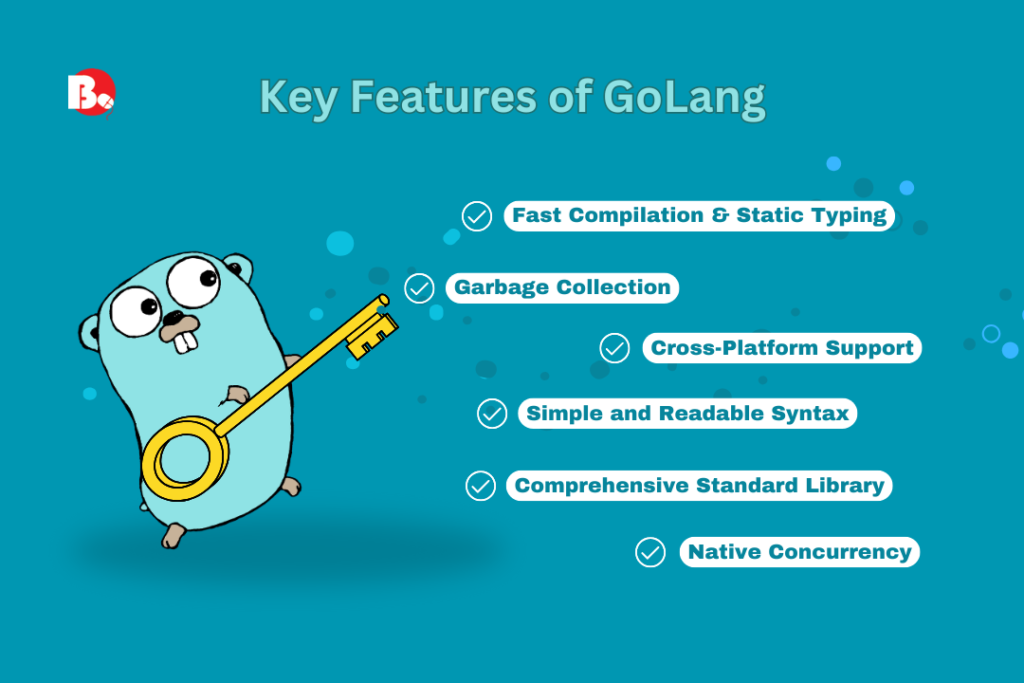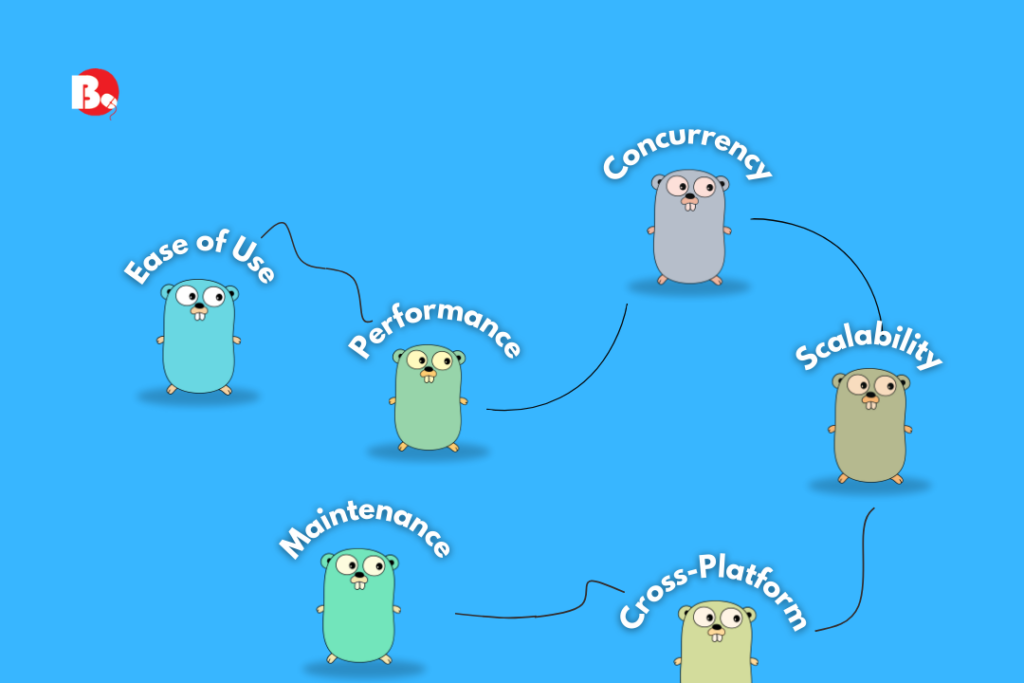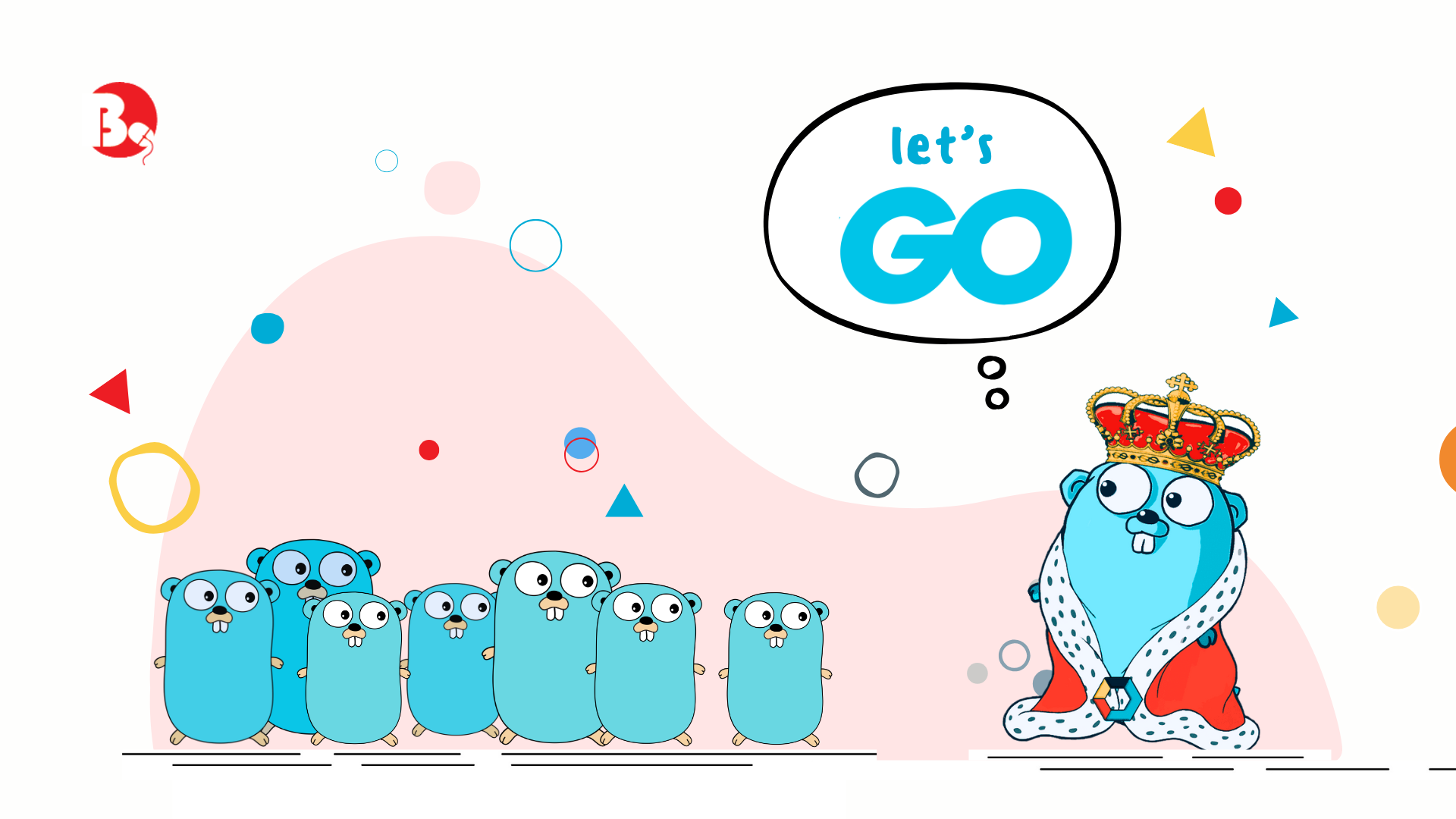As a developer who has existed since the age of old school Python and C++, I faced the headache of slow development cycles?
However, the introduction of GoLang changed the scenario for me. It feels like a sleek instrument of programming languages.
Born from Google’s need for speed and simplicity, GoLang swoops in to tackle programming problems with its lightning-fast compilation and clean, readable syntax.
Let’s talk about it in detail!
Key Takeaways
- GoLang’s clean syntax and strong concurrency support make it easy to use.
- Developers enjoy its readability and simple learning curve.
- Big names like Uber and Netflix rely on GoLang.
- Plenty of resources and a helpful community make starting out a breeze.
Table of Contents
- What is GoLang & Why It Matters?
- Key Features of GoLang
- Advantages of GoLang
- GoLang in Action: Real-World Applications
- Learning Resources for GoLang
- Key Takeaways
- Conclusion
What is GoLang & Why It’s Popular?
GoLang, also known as Go, has a pretty interesting origin story. It was created by three brilliant Google engineers: Robert Griesemer, Rob Pike, and Ken Thompson. This trio started working on Go in 2007, aiming to solve some headaches they faced with existing programming languages. By 2009, they released Go as an open-source language.
The main goals were clear and ambitious:
- Simplify the development process
- Enhance concurrency support
- Improve compilation speed
In other words, they wanted a language that was easy to use, could handle multiple tasks at once, and was fast.
The programming language has certainly made its mark in modern software development. It combines the readability and simplicity of C with some powerful, modern features. This makes it a favorite among developers who need to write clean, efficient, and reliable code.
One of the reasons for its popularity is its quirky mix of old and new. It feels familiar, yet fresh. The language is straightforward, which reduces the learning curve. But don’t let that simplicity fool you. GoLang is packed with features that make it a powerhouse for developing modern applications.
In short, GoLang is a language designed to make developers’ lives easier while keeping up with the demands of today’s tech world. It’s no wonder it’s gaining so much traction.
Key Features of GoLang
GoLang is packed with features that make it a powerful tool for modern software development. It’s a language that gets out of your way, allowing you to focus on building great software. Check out some of the outstanding features:

Simplicity and Readability
When it comes to GoLang, simplicity and readability are its crown jewels. Its syntax is clean and minimalistic. There are fewer keywords and constructs to remember, making the code look tidy and easy to follow. This design choice reduces the cognitive load on developers, allowing them to focus on what really matters: solving problems and building great software.
Statically Typed
The language is statically typed, which means variable types are checked at compile-time. This enhances code reliability and prevents many runtime errors. It’s like having a built-in safety net. Plus, GoLang supports type inference. This means you don’t always have to specify types explicitly, saving time and keeping the code neat.
Concurrency Support
Concurrency support is where GoLang truly shines. It offers goroutines, which are like lightweight threads of execution. These allow you to perform multiple tasks simultaneously without much overhead. To safely communicate between goroutines, GoLang uses channels. This system is inspired by the Communicating Sequential Processes (CSP) model, making concurrent programming more manageable and less error-prone.
Garbage Collection
Garbage collection is another standout feature. GoLang handles automatic memory management, which means developers don’t have to manually allocate and deallocate memory. This prevents common bugs like dangling pointers and memory leaks. You can focus on coding, knowing that GoLang has your back when it comes to memory management.
Fast Compilation
Fast compilation is a big deal in GoLang. The language is designed for rapid build times and quick iteration. It uses aggressive inlining and parallel compilation techniques to speed up the process. This means you can write code, compile it, and see the results in no time. It’s all about keeping the development flow smooth and efficient.
Cross-Platform Compatibility
Cross-platform compatibility is a breeze with GoLang. It compiles to native binaries for Windows, Linux, and macOS. This makes it easy to build portable and distributable applications. You write your code once, and it can run anywhere. It’s like having a universal key that opens every door.
Comprehensive Standard Library
Go is known for its comprehensive standard library, which is like having a Swiss Army knife for developers. It comes with built-in support for file operations, networking, cryptography, and more. This means you can handle a wide range of tasks without needing to reach for external dependencies. It keeps things streamlined and efficient, allowing you to focus on building your application instead of hunting for third-party libraries.
Strict Dependency Management
Speaking of management, GoLang’s strict dependency management is a dream come true. This approach promotes reproducible builds, making it easier to manage and version dependencies for your projects. You won’t have to deal with “dependency hell,” a common issue in many other languages. With GoLang, what you see is what you get. It ensures that your project remains stable and predictable, even as it grows.
Interface-Based Polymorphism
Interface-based polymorphism in GoLang is a game-changer. Polymorphism through interfaces enables code reuse and abstraction without the need for explicit inheritance or complex class hierarchies. It’s like having a flexible toolkit that adapts to your needs. Interfaces in Go are implicitly satisfied by types that implement the required methods, supporting a form of duck typing. This approach keeps your codebase clean and simple, enhancing maintainability and readability.
Built-in Testing
Testing is baked right into GoLang with its built-in testing package. This feature encourages test-driven development (TDD), ensuring that your code is reliable and robust. Writing unit tests is straightforward, and running them is even easier. This built-in support means you can catch bugs early, maintain high code quality, and have more confidence in your code. It’s like having a built-in safety net that ensures you’re always on the right track.
Efficient Compilation to Machine Code
GoLang’s ability to compile directly to machine code is another standout feature. This results in high-performance executables that are perfect for systems requiring low-level control and performance. Whether you’re working on an operating system, a database, or a network server, GoLang’s efficient compilation ensures your applications run smoothly and quickly. You get the speed and efficiency you need without sacrificing ease of use.
Advantages of GoLang

Performance: GoLang shines with its high performance. It compiles efficiently to machine code, ensuring your applications run swiftly and smoothly. You get the speed without the hassle.
Ease of Use: The syntax is simple and the code structure is clear. Writing GoLang feels natural and intuitive. It’s like a breath of fresh air for developers used to more complex languages.
Concurrency: Concurrency support in GoLang is top-notch. With goroutines and channels, handling multiple tasks simultaneously is a breeze. Your applications can do more without getting bogged down.
Scalability: GoLang is built for scalability. Its concurrency features and fast performance make it perfect for applications that need to grow and handle more load efficiently. Think big, build big.
Maintenance: Maintaining GoLang code is straightforward. Its minimalistic design and clear syntax make it easy to read and update. Less time deciphering, more time improving.
Cross-Platform: GoLang natively supports multiple platforms. Whether you’re developing for Windows, Linux, or macOS, GoLang has you covered. One codebase, many destinations.
Application of GoLang in Real-World
Uber
Uber relies on GoLang to manage its high volume of requests. When you hail a ride, GoLang’s concurrency features ensure you connect with a driver quickly. It’s all about speed and efficiency. GoLang helps Uber handle multiple tasks simultaneously, making sure the app runs smoothly even during peak hours. In a bustling city, every second counts, and GoLang keeps Uber moving.
Monzo
Monzo, a digital bank, chose GoLang for its backend infrastructure. This decision allows Monzo to maintain a fast and responsive app for its users. GoLang’s simplicity and efficiency help Monzo handle a growing user base seamlessly. The language’s concurrency support ensures smooth transaction processing. Monzo’s switch to GoLang has enhanced its ability to innovate and offer top-notch banking services.
Netflix
Netflix uses GoLang to manage its content delivery network. This ensures your binge-watching sessions are buffer-free. GoLang’s efficiency plays a crucial role in delivering high-quality streams globally. Its fast compilation times and robust concurrency support are perfect for handling Netflix’s massive data and user interactions. Thanks to GoLang, your favorite shows are just a click away.
Twitch
Twitch utilizes GoLang for its chat functionality and real-time video processing. GoLang’s ability to handle numerous connections at once makes it ideal for this platform. It ensures low latency and smooth communication during live streams. This is vital for an interactive experience where gamers and viewers can connect instantly. GoLang’s efficiency keeps the community engaged and the streams flowing.
Dropbox
Dropbox leverages GoLang for various backend services, including its sync engine. This choice enhances performance and security for users sharing files. GoLang’s fast compilation and efficient memory management are key here. It allows Dropbox to handle large amounts of data seamlessly. Users benefit from quick uploads and downloads, ensuring their precious memories are always within reach.
Alibaba
Alibaba uses GoLang to handle the massive traffic on its online marketplace. GoLang’s concurrency support and scalability are perfect for managing complex transactions. This ensures a smooth shopping experience, whether you’re buying the latest gadgets or traditional crafts. Alibaba’s trust in GoLang highlights its ability to support large-scale e-commerce operations efficiently.
Kubernetes
Kubernetes, developed by Google, extensively uses GoLang. The language’s focus on automation and concurrency is ideal for managing containerized applications. GoLang’s efficiency and simplicity make it perfect for orchestrating complex cloud deployments. Kubernetes’ success with GoLang showcases the language’s capability to handle modern infrastructure needs effectively.
As the birthplace of GoLang, Google uses it across various projects. From cloud services to internal tools, GoLang’s simplicity and performance are invaluable. Its development was driven by the need for a language that combined readability with powerful features. Google’s extensive use of GoLang underscores its trust in the language’s ability to deliver robust solutions.
Other Notable Users
GoLang’s appeal extends to many other major players. The BBC uses it for their content management system. Docker relies on it for containerization. SoundCloud’s backend infrastructure benefits from GoLang’s efficiency. These notable users highlight GoLang’s versatility and reliability across diverse applications. Whether it’s media, technology, or music, GoLang proves to be a reliable choice.
Learning Resources for GoLang
Below are some options offering a solid foundation for mastering Go:
Go Tour- Launchpad for Beginners
Start your GoLang journey with the Go Tour. This interactive guide walks you through GoLang’s syntax and features with hands-on exercises you can complete right in your browser. It’s a great way to get acquainted with GoLang’s basics and start coding without setup hassles. The Go Tour makes learning fun and immediate, offering practical experience right from the start.
Online Courses- Structured Learning Paths
For a more structured approach, check out online courses on platforms like Coursera, Udemy, and Pluralsight. These courses offer a mix of video lectures, quizzes, and real-world projects to help you learn GoLang effectively. Coursera and Udemy provide beginner to advanced content, while Pluralsight offers in-depth courses for those looking to master GoLang. These platforms ensure a thorough understanding through well-designed, engaging material.
Diving Deeper with Books
Once you’re comfortable with the basics, dive deeper with recommended books. “The Go Programming Language” by Alan A.A. Donovan and Brian W. Kernighan is a comprehensive guide that covers both fundamentals and advanced features. “Go in Action” by William Kennedy, Erik St. Martin, and Brian Ketelsen provides practical insights into GoLang applications. “Introducing Go” by Caleb Doxsey offers a beginner-friendly introduction. These books are rich in examples and exercises to solidify your knowledge.
The Official Resource
The GoLang documentation is an essential resource. It’s detailed, up-to-date, and easy to navigate, offering explanations, code examples, and best practices. It’s your go-to reference for understanding GoLang’s features and resolving issues.
The GoLang Community
Engage with the GoLang community through forums like Stack Overflow, Reddit’s r/golang, and local meetups. The community is known for being supportive and helpful, providing a network of experienced developers and enthusiasts ready to assist with your learning journey.
Getting Started with GoLang
Ready to dive into GoLang? Here’s a quick guide to get you up and running on a Windows computer.
GoLang Download and Install
- Head over to the official Go downloads page at golang.org/dl.
- Choose the right package for your system. If you’re on a 64-bit Windows, select the “Windows 64-bit” package.
- Click the download link and save the file.
- Once downloaded, open the file and follow the installation wizard.
- Choose a memorable directory for Go, like “C:\Go”.
- Complete the installation and open a command prompt. Type go version to confirm GoLang is installed correctly.
Start Coding
- Navigate to your Go project directory in the command prompt.
- Initialize your Go module with go mod init <application-folder>. Replace <application-folder> with your project name.
- To run your code, use go run <application.go>. Replace <application.go> with your file name.
And there you have it! GoLang is now installed and ready for action. Start experimenting and building with one of the most exciting languages in tech today.
Thanks for reading! I hope this dive into GoLang’s world was both enlightening and helpful. If you have any questions or just want to chat about GoLang, drop me a line in the comment section.


I am really impressed together with your writing abilities and also
with the layout for your weblog. Is this a paid theme or did you customize it yourself?
Either way stay up the nice high quality writing, it is uncommon to see a great blog like this
one today. Beacons AI!
Hey! Great to hear from you. Team Blogster is pleased to know that your find it valuable. This is a customized theme and we just started with it. Your support is valued. Thank you and keep reading from us.